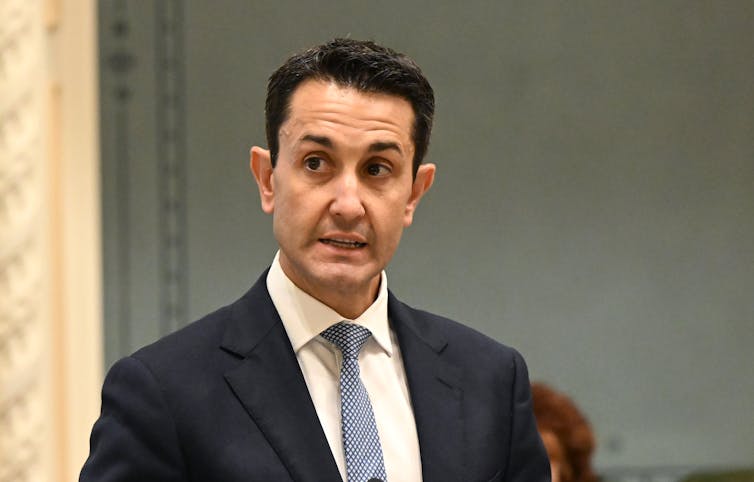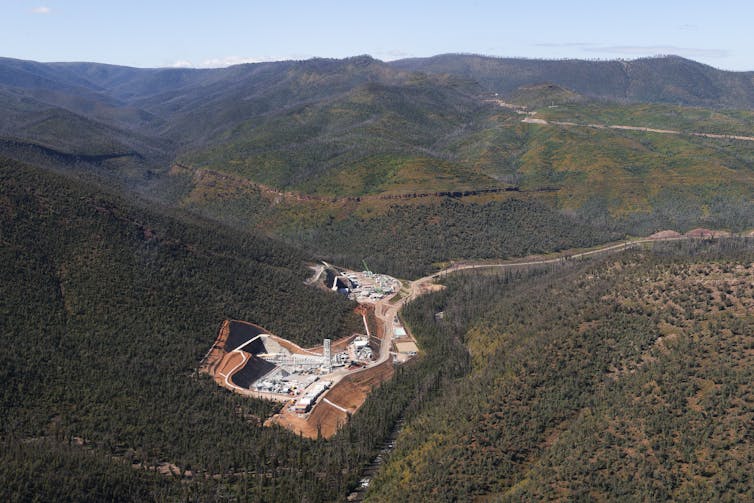In 1971 on a family holiday, my father drove us to look at a huge concrete slab at Jervis Bay, on the South Coast of New South Wales. Still visible today, it was the foundation for what would have been Australia’s first nuclear power plant.
The project had just been cancelled by then-prime minister Billy McMahon who had recently replaced John Gorton. A Treasury analysis showed coal-fired power was much cheaper.
That long-ago episode is still relevant to Australia’s policy choices. Today, Opposition leader Peter Dutton revealed seven sites across Australia where the Coalition, if elected, would build nuclear power stations. Unsurprisingly, the plan has already run into opposition from state politicians, both Labor and the LNP.
The announcement answers a few basic questions about the Coalition’s nuclear plans. For example, Dutton said the plants would be Commonwealth-owned, and built at the site of decommissioned coal plants. But central issues remain unaddressed. Exactly what kind of reactors will be built? Who will build them? And how much they will cost?
As the Jervis Bay experience shows, nuclear energy can be a hard sell in Australia. Times have obviously changed since the 1970s, but significant political and economic barriers remain – and the problem of cost is still unsolved.
What the Coalition has revealed
The seven sites for nuclear power plants mooted by the Coalition are:
- Tarong and Callide in Queensland
- Liddell and Mount Piper in NSW
- Port Augusta in South Australia
- Loy Yang in Victoria
- Muja in Western Australia.
At a press conference in Sydney, Dutton said:
We know the government has [a] renewables only policy which is not fit for purpose. No other country in the world can keep the lights on 24/7 with the renewables only policy.
We want to utilise existing assets that we have got […] new poles and wires that are used at the moment on the coal-fired power station sites can be utilised to distribute the energy generated from the latest generation nuclear reactors.
Under the Coalition plan, the federal government would own and pay for the plants. In this respect, Dutton is following the precedent set by the Snowy Scheme – and more recently, by the National Broadband Network.
This is a welcome acknowledgement of the reality that, whatever technology we adopt, private investment is likely insufficient to manage the transition away from coal and gas in the electricity sector – let alone the massive electrification in other sectors needed to meet Australia’s 2050 emissions targets.
Dutton says he remains committed to the 2050 target for now, despite flagging the Coalition will abandon Australia’s 2030 emissions goal.
The Coalition says it will develop two “establishment projects” using either small modular reactors or larger plants. It claims the small reactors will start producing electricity by 2035, and the larger plants by 2037.
These timeframes are at odds with analysis by the CSIRO, which recently found reactors could not be operational in Australia until 2040 at the earliest.
The same report found construction of a large-scale nuclear power facility would cost at least A$8.6 billion, and possibly up to $17 billion. It said the electricity produced would be about 50% more costly than renewable energy.
On Wednesday, Dutton refused to provide a price tag for the Coalition policy. But he claimed it would be a “fraction” of Labor’s renewable energy policy.

Lessons from Jervis Bay
Dutton this week ruled out Jervis Bay as a nuclear reactor location, should the Coalition win the next federal election. But the 1970s experience still holds valuable lessons.
The Jervis Bay territory was ruled directly by the federal government – circumventing any potential state opposition. The Coalition faces a different battle with regards to its proposed sites.
Queensland LNP Leader David Crisafulli on Wednesday said he did not support Dutton’s plan for a nuclear power station in Central Queensland, and has previously ruled out lifting a state ban on nuclear power if elected in October.
NSW Labor Premier Chris Minns says building a nuclear reactor in the Hunter Valley is impossible under existing laws, and would disrupt the renewable energy transition.
Dutton pledged to work with state premiers to resolve such issues, and suggested financial incentives would be offered.

It’s unclear whether existing coal plant owners, including state-owned generators, will be willing to sell the sites to the federal government. However, Dutton said on Wednesday that, according to legal advice, the government could compulsorily acquire the sites if needed.
When Jervis Bay was on the table as a nuclear site, there was no question the federal government would build, own and operate it. The idea that something as crucial as a nuclear power plant might be entrusted to a state government, let alone a foreign corporation, was never entertained.
The national government was at the postwar height of its power and confidence. It employed the best and brightest, and was expanding the scope and scale of its activity. The Snowy Mountains Scheme, a massive engineering endeavour built under the Commonwealth’s defence power, was nearing completion.
Dutton says the government will own the proposed nuclear plants, but form partnerships with nuclear companies to build and operate them. But which companies?
Internationally, about 60 nuclear plants are under construction, mostly in Asia. The vast majority are Chinese and Russian designs, built by Chinese and Russian firms. Presumably, for national security reasons, that is not an option for Australia.
The only real contenders for large modern projects in Australia are South Korea’s KEPCO, and Electricity de France (EDF).
KEPCO built four plants at Barakah, in the United Arab Emirates, between 2009 and 2024. But no new orders for KEPCO plants outside South Korea have been announced since 2009.
EDF is building a reactor at Flamanville in France and two at Hinkley Point in the United Kingdom. The projects have suffered massive delays and cost overruns. The UK government is also struggling to organise finance for an additional EDF reactor proposed at the existing Sizewell plant.

And what about the so-called small modular reactors suggested by Dutton? This term is applied to two types of technology.
First, there are reactors of less than 100 megawatt capacity, which would be built in a factory and shipped to the required site where they would be installed as individual modules.
The most promising contender was the NuScale Voygr design, however its pilot project has been abandoned. Similarly, Rolls Royce has spiked its plans for a factory in Wales that would have progressed technology used in small modular reactors.
The term is also applied to cut-down versions of existing large-scale designs: reactors of 300 to 500 megawatt capacity compared to the traditional 1,000 to 1,500 megawatts. These are “modular” only in the sense that most parts are built in factories and assembled onsite.
The government of Ontario in Canada has announced plans for four such reactors to be built by GE-Hitachi, but no final commitment has been made.
Meanwhile, the climate crisis continues
As the next federal election rolls closer, Dutton will come under pressure to reveal crucial details underpinning the Coalition’s nuclear plan – most importantly, how much it will cost.
Nothing announced by Dutton today changes the fact that nuclear energy is, according to reams of expert analysis, economically unfeasible in Australia. This is as true today as it was in the 1970s.
Meanwhile, the climate crisis continues to worsen. Solar panels, wind turbines and energy storage must be rolled out as rapidly as possible – and we must not allow Dutton’s policy detour to distract from the task.

